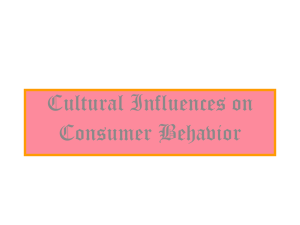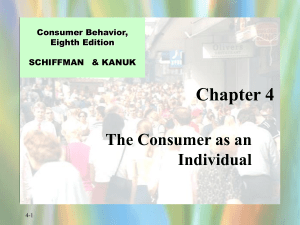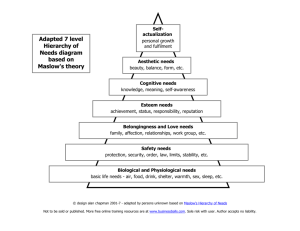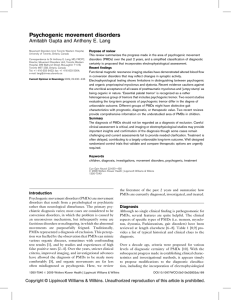week2 - motivation - University of San Diego Home Pages
advertisement
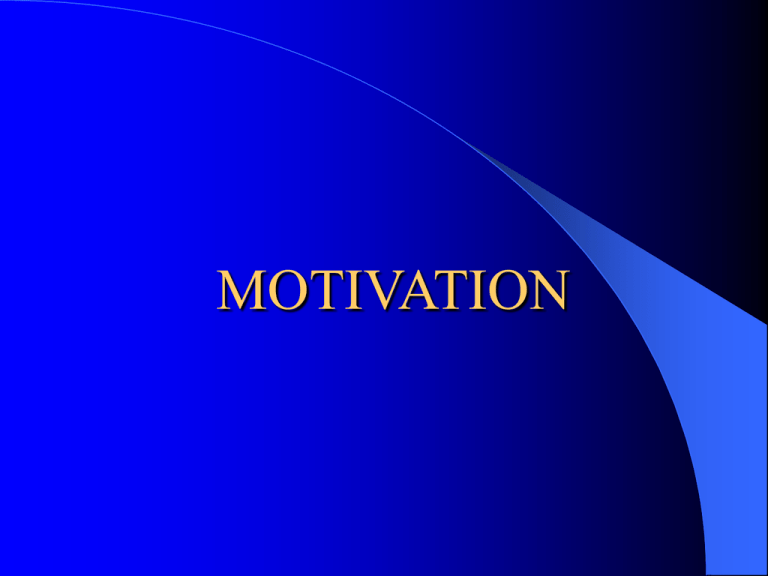
MOTIVATION Definition Motivation is an inner state of arousal that denotes energy to achieve a specific goal: To Satisfy my needs.* Motivation represents the drive to satisfy needs through product purchase and consumption * Motivation comes from latin motus which means to move Drive The degree of arousal present due to a discrepancy between the consumer’s present state and some ideal state Motivation Process Opportunity or Need (arousal , stress) Two major components: Energy (Strength) and Direction Goal (equilibrium) Behavior (triggered by signal) Does Marketing Create Needs? Needs: internal state of tension caused by desiquilibrium from an ideal or desired state. Biogenic vs psychogenic: innate vs acquired. Social vs Non social; functional, symbolic vs Hedonic. Maslow Classification. Wants: A Manifestation of the need created by personal and cultural factors. Mc Donald’s or Outback. Non-for profit organization or golf membership. Innate Needs Physiological needs for food, water, air, clothing, shelter, and sex. Also known as biogenic or primary needs. Does Marketing Create Needs? Needs: internal state of tension caused by desiquilibrium from an ideal or desired state. Biogenic vs psychogenic: innate vs acquired. Social vs Non social; functional, symbolic vs Hedonic. Maslow Classification. Wants: A Manifestation of the need created by personal and cultural factors. Mc Donald’s or Outback. Non-for profit organization or golf membership. Acquired Needs Needs that are learned in response to one’s culture or environment (such as the need for esteem, prestige, affection, or power). Also known as psychogenic or secondary needs. back Exhibit 3.6: Types of Needs Maslow’s Hierarchy of Needs Figure 4.11 Appeal to SelfActualization Figure 4.12 Appeal to Power Needs Figure 4.13 Appeal to Affiliation Needs Figure 4.14 Appeal to Achieveme nt Needs Criticisms of Maslow’s Hierarchy The application is too simplistic: – It is possible for the same product or activity to satisfy every need. It is too culture-bound: – The assumptions of the hierarchy may be restricted to Western culture It emphasizes individual needs over group needs – Individuals in some cultures place more value on the welfare of the group (belongingness needs) than the needs of the individual (esteem needs) Motivational Research Qualitative research designed to uncover consumers’ subconscious or hidden motivations. Consumers are not always aware of, or may not wish to recognize, the basic reasons underlying their actions. Motivations and Goals Positive Motivation Negative Motivation – A driving force – A driving force toward some away from some object or condition object or condition Approach Goal Avoidance Goal – A positive goal toward which behavior is directed – A negative goal from which behavior is directed away Motivational Conflicts Approach-Approach Conflict: – A person must choose between two desirable alternatives. – Theory of Cognitive Dissonance: A state of tension occurs when beliefs or behaviors conflict with one another. Cognitive Dissonance Reduction: Process by which people are motivated to reduce tension between beliefs or behaviors. Approach-Avoidance Conflict: – Exists when consumers desire a goal but wish to avoid it at the same time. Avoidance-Avoidance Conflict: – Consumers face a choice between two undesirable alternatives. Negative Consequences The Partnership for a Drug-Free America points out the negative consequences of drug addiction for those who are tempted to start. back What Affects Motivation? Perceived Risk Risk and Involvement Perceived Risk Consumer Motivation : Involvement Involvement: – A person’s perceived relevance of the object based on his/her inherent needs, values, and interests. Object: A product or brand Felt Involvement – – – – Enduring Situational Cognitive Affective Consumer Motivation : Involvement Objects of Involvement – Involvement with Product – – – – – Categories Involvement with Brands Involvement with Ads Involvement with a Medium Involvement with Decisions Specifying the Object of Involvement Conceptualizing Involvement High Involvement Increasing Involvement through Ads The Swiss Potato Board is trying to increase involvement with its product. The ad reads, “Recipes against boredom.” Customizing for Product Involvement Strategies to Increase Involvement Appeal to hedonic needs – e.g. using sensory appeals to generate attention Use novel stimuli – e.g. unusual cinematography, sudden silences, etc. Use prominent stimuli – e.g. larger ads, more color Include celebrity endorsers Build a bond with consumers – Maintain an ongoing relationship with consumers Measuring Involvement Teasing out the Dimensions of Involvement: – Involvement Profile: Personal interest in a product category Risk importance Probability of making a bad purchase Pleasure value of the product category How closely the product is related to the self – Zaichkowsky’s Personal Involvement Inventory Scale Segmenting by Involvement Levels: – Involvement is a useful basis for market segmentation Theories to explain Motivation ? Freud’s theory or Psychoanalytic Theory Ego : conscient part of psyche (perceptions, memory, feelings…). Super ego : Judge. Dictate proper behavior. Socially learned (rules, laws). Primarly unconscious. Id : natural instincts, physiologically based, repressed, internal. Use of theory in Marketing. To satisfy three components. To shake Id and free psyche energy. Consumer Ability: Resources to Act Product Knowledge and Experience Cognitive Style Intelligence,Education, and Age Money Consumer Opportunity Time Distraction Amount of Information Complexity of Information Repetition of Information The Challenge of Understanding Consumer Motivation Similar needs do not always lead to similar behaviors. Different needs may lead to similar behaviors. People don’t always want to disclose real reasons for their actions People don’t always know why they do what they do--unconscious motivation Efficiency do not always increase with motivation Different Appeals for Same Goal Object

